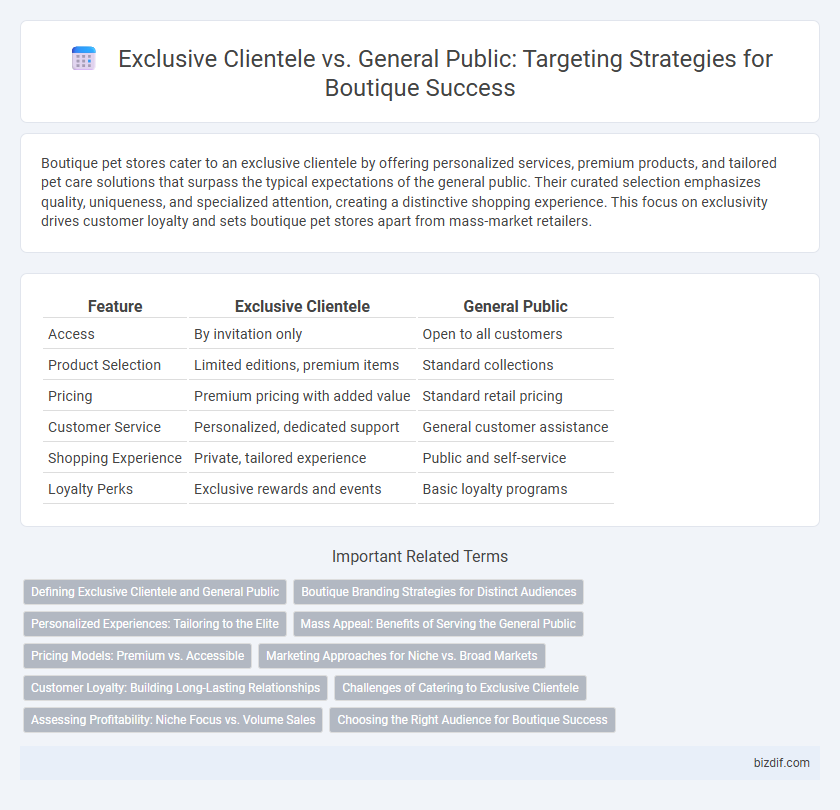Boutique pet stores cater to an exclusive clientele by offering personalized services, premium products, and tailored pet care solutions that surpass the typical expectations of the general public. Their curated selection emphasizes quality, uniqueness, and specialized attention, creating a distinctive shopping experience. This focus on exclusivity drives customer loyalty and sets boutique pet stores apart from mass-market retailers.
Table of Comparison
| Feature | Exclusive Clientele | General Public |
|---|---|---|
| Access | By invitation only | Open to all customers |
| Product Selection | Limited editions, premium items | Standard collections |
| Pricing | Premium pricing with added value | Standard retail pricing |
| Customer Service | Personalized, dedicated support | General customer assistance |
| Shopping Experience | Private, tailored experience | Public and self-service |
| Loyalty Perks | Exclusive rewards and events | Basic loyalty programs |
Defining Exclusive Clientele and General Public
Exclusive clientele refers to a select group of customers who receive personalized services, limited-edition products, and priority access, often characterized by high purchasing power and brand loyalty. The general public encompasses the broader market segment with standard access to products and services without specialized treatment or exclusivity. Understanding these distinctions allows boutiques to tailor marketing strategies and customer experiences effectively.
Boutique Branding Strategies for Distinct Audiences
Boutique branding strategies for exclusive clientele emphasize personalized services, limited edition products, and a curated shopping experience to foster loyalty and brand prestige. In contrast, targeting the general public involves broader accessibility, competitive pricing, and mass marketing campaigns to drive volume and brand awareness. Tailoring messaging and offerings to these distinct audiences ensures optimized engagement and sustained growth within luxury and mainstream market segments.
Personalized Experiences: Tailoring to the Elite
Boutiques catering to an exclusive clientele emphasize personalized experiences by customizing products and services to meet the unique preferences of elite customers. This approach contrasts with mass-market retailers targeting the general public, where offerings are standardized to appeal to broader audiences. Tailored consultations, limited editions, and bespoke designs foster a sense of exclusivity, enhancing customer loyalty within high-net-worth segments.
Mass Appeal: Benefits of Serving the General Public
Serving the general public expands a boutique's reach, allowing for increased sales volume and diversified revenue streams beyond niche markets. Mass appeal creates brand recognition and customer loyalty by offering accessible, high-quality products that resonate with a broader audience. By balancing exclusivity with inclusivity, boutiques can sustain growth while maintaining distinctiveness in a competitive retail landscape.
Pricing Models: Premium vs. Accessible
Boutiques targeting an exclusive clientele implement premium pricing models that emphasize unique craftsmanship, limited editions, and personalized services, reinforcing brand prestige and perceived value. In contrast, boutiques catering to the general public adopt accessible pricing strategies to maximize reach and volume, balancing quality with affordability to attract wider customer bases. These differentiated pricing models directly influence customer experience, brand positioning, and market segmentation within the boutique industry.
Marketing Approaches for Niche vs. Broad Markets
Boutiques targeting an exclusive clientele employ personalized marketing strategies, emphasizing luxury, limited availability, and bespoke experiences to foster brand loyalty and high perceived value. Marketing to the general public involves broad-reach campaigns leveraging social media, discounts, and mass appeal messaging to attract diverse customer segments. Tailoring marketing approaches to niche audiences maximizes engagement through exclusivity, while broad market strategies prioritize volume and brand accessibility.
Customer Loyalty: Building Long-Lasting Relationships
Boutiques thrive on cultivating exclusive clientele by offering personalized experiences and tailored services that foster deep customer loyalty. Unlike the general public, exclusive clients receive specialized attention, creating emotional connections and trust that encourage repeat business and referrals. This strategic focus on individual relationships enhances brand value and sustains long-lasting customer retention in a competitive retail market.
Challenges of Catering to Exclusive Clientele
Catering to an exclusive clientele in a boutique demands personalized services and curated experiences that meet high expectations for quality and uniqueness, presenting challenges in maintaining consistent brand exclusivity. Balancing limited product availability with bespoke customization options requires precise inventory management and skilled staff trained to deliver discretion and exceptional customer care. The boutique must also navigate confidentiality concerns while fostering a sense of privilege and loyalty among discerning customers.
Assessing Profitability: Niche Focus vs. Volume Sales
Boutiques targeting an exclusive clientele often achieve higher profit margins through premium pricing and personalized services, leveraging brand prestige to maximize per-customer revenue. In contrast, appealing to the general public relies on volume sales with lower margins, demanding cost-efficient operations and broad market reach to ensure profitability. Assessing profitability involves analyzing customer acquisition costs, average transaction value, and repeat purchase rates tailored to either niche focus or mass-market strategies.
Choosing the Right Audience for Boutique Success
Targeting an exclusive clientele allows boutiques to create a personalized, luxury shopping experience that drives higher profit margins and brand loyalty. In contrast, catering to the general public demands scalable operations and broader marketing strategies, often resulting in lower per-unit revenue but increased volume. Understanding customer demographics and purchasing behavior is essential for boutiques to align their brand positioning with the most profitable and sustainable audience segment.
Exclusive clientele vs General public Infographic

 bizdif.com
bizdif.com